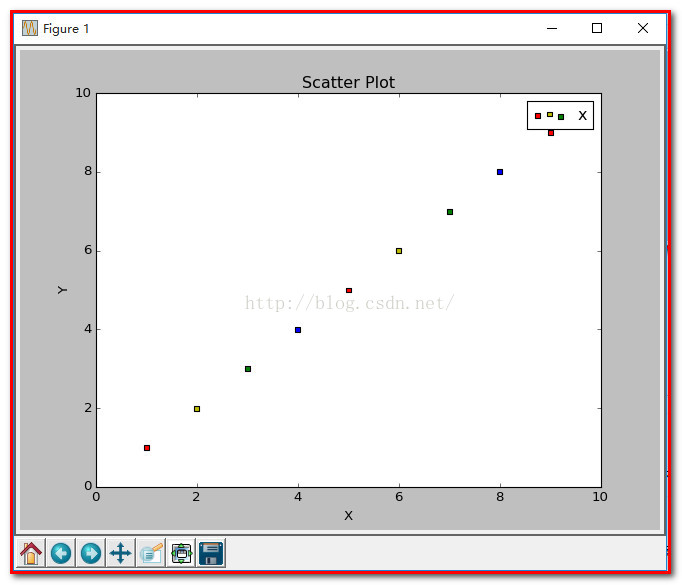Python中scatter函数参数及用法详解
2017-11-08 16:26
1576 查看
最近开始学习Python编程,遇到scatter函数,感觉里面的参数不知道什么意思于是查资料,最后总结如下:
1、scatter函数原型

2、其中散点的形状参数marker如下:

3、其中颜色参数c如下:

4、基本的使用方法如下:
#导入必要的模块
import numpy as np
import matplotlib.pyplot as plt
#产生测试数据
x = np.arange(1,10)
y = x
fig = plt.figure()
ax1 = fig.add_subplot(111)
#设置标题
ax1.set_title('Scatter Plot')
#设置X轴标签
plt.xlabel('X')
#设置Y轴标签
plt.ylabel('Y')
#画散点图
ax1.scatter(x,y,c = 'r',marker = 'o')
#设置图标
plt.legend('x1')
#显示所画的图
plt.show()
结果如下:

5、当scatter后面参数中数组的使用方法,如s,当s是同x大小的数组,表示x中的每个点对应s中一个大小,其他如c,等用法一样,如下:
(1)、不同大小
#导入必要的模块
import numpy as np
import matplotlib.pyplot as plt
#产生测试数据
x = np.arange(1,10)
y = x
fig = plt.figure()
ax1 = fig.add_subplot(111)
#设置标题
ax1.set_title('Scatter Plot')
#设置X轴标签
plt.xlabel('X')
#设置Y轴标签
plt.ylabel('Y')
#画散点图
sValue = x*10
ax1.scatter(x,y,s=sValue,c='r',marker='x')
#设置图标
plt.legend('x1')
#显示所画的图
plt.show()

(2)、不同颜色
#导入必要的模块
import numpy as np
import matplotlib.pyplot as plt
#产生测试数据
x = np.arange(1,10)
y = x
fig = plt.figure()
ax1 = fig.add_subplot(111)
#设置标题
ax1.set_title('Scatter Plot')
#设置X轴标签
plt.xlabel('X')
#设置Y轴标签
plt.ylabel('Y')
#画散点图
cValue = ['r','y','g','b','r','y','g','b','r']
ax1.scatter(x,y,c=cValue,marker='s')
#设置图标
plt.legend('x1')
#显示所画的图
plt.show()
结果:

(3)、线宽linewidths
#导入必要的模块
import numpy as np
import matplotlib.pyplot as plt
#产生测试数据
x = np.arange(1,10)
y = x
fig = plt.figure()
ax1 = fig.add_subplot(111)
#设置标题
ax1.set_title('Scatter Plot')
#设置X轴标签
plt.xlabel('X')
#设置Y轴标签
plt.ylabel('Y')
#画散点图
lValue = x
ax1.scatter(x,y,c='r',s= 100,linewidths=lValue,marker='o')
#设置图标
plt.legend('x1')
#显示所画的图
plt.show()

注: 这就是scatter基本的用法。
PS:下面举个示例
本文记录了python中的数据可视化――散点图scatter,令x作为数据(50个点,每个30维),我们仅可视化前两维。labels为其类别(假设有三类)。
这里的x就用random来了,具体数据具体分析。
label设定为[1:20]->1, [21:35]->2, [36:50]->3,(python中数组连接方法:先强制转为list,用+,再转回array)
用matplotlib的scatter绘制散点图,legend和matlab中稍有不同,详见代码。
x = rand(50,30) from numpy import * import matplotlib import matplotlib.pyplot as plt #basic f1 = plt.figure(1) plt.subplot(211) plt.scatter(x[:,1],x[:,0]) # with label plt.subplot(212) label = list(ones(20))+list(2*ones(15))+list(3*ones(15)) label = array(label) plt.scatter(x[:,1],x[:,0],15.0*label,15.0*label) # with legend f2 = plt.figure(2) idx_1 = find(label==1) p1 = plt.scatter(x[idx_1,1], x[idx_1,0], marker = 'x', color = 'm', label='1', s = 30) idx_2 = find(label==2) p2 = plt.scatter(x[idx_2,1], x[idx_2,0], marker = '+', color = 'c', label='2', s = 50) idx_3 = find(label==3) p3 = plt.scatter(x[idx_3,1], x[idx_3,0], marker = 'o', color = 'r', label='3', s = 15) plt.legend(loc = 'upper right')
result:
figure(1):

figure(2):

以上就是本文的全部内容,希望对大家的学习有所帮助,也希望大家多多支持脚本之家。
您可能感兴趣的文章:
相关文章推荐
- Python中scatter函数参数详解
- python_9(获取字典值、函数参数、函数返回值、lambda的函数用法)
- python sorted()函数cmp,key,reverse参数详解
- Python学习之基础语言篇——函数参数详解
- python中的含有 *args 和**kwargs的用法 作为参数的函数,参数输入问题
- 详解Python中where()函数的用法
- Python中函数的参数定义和可变参数用法实例分析
- WordPress分类列表函数:wp_list_categories用法及参数详解举例
- Python学习笔记5:函数参数详解
- Python可变参数函数用法实例
- Python3 print()函数sep,end,file参数用法练习
- Python函数可变参数定义及其参数传递方式实例详解
- PHP入门教程之自定义函数用法详解(创建,调用,变量,参数,返回值等)
- Python3正则匹配re.split,re.finditer及re.findall函数用法详解
- Python help()函数用法详解
- Python自定义函数的创建、调用和函数的参数详解 .argmax
- Python基础之函数用法实例详解
- PYthon——plt.scatter各参数详解
- Python3.2中Print函数用法实例详解
- scatter函数参数详解
